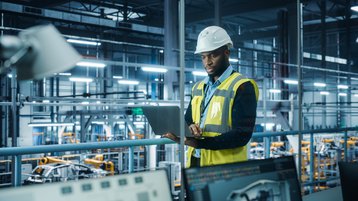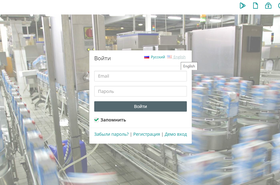The world of manufacturing is extremely competitive, with massive conglomerates all vying for that competitive edge, while smaller outfits look to survive long enough to become a conglomerate.
Increasingly, as we move to a more digitized version of factories, it has become apparent that what can give the manufacturing industry that competitive edge is, well, the Edge.
The digital revolution brings with it the essential need for digital infrastructure, and as we progress towards smart and even dark factories, that infrastructure will need to change its form.
Welcome ‘Industry 4.0’
‘Smart factories’ is something of a buzzphrase, like ‘Edge’ itself. But, despite the danger of overuse devaluing the concept, more and more manufacturers are adopting some principles into their facilities that deserve the description.
The smart factory curates data via sensors on the machines and around the factory floor, analyzes the data, and learns from experience. In order to do this effectively, that processing has to happen where the action is.
“There will potentially be thousands of sensors, and they’re all collecting data, which then needs to be analyzed,” explains Matt Bamforth, senior consultant at STL Partners.
“This is a huge amount of data, and it would be extremely expensive to send all of this back to a central server in the cloud. So in analyzing and storing this data at the Edge, you can reduce the backhaul.”
According to Bamforth, Edge computing will leverage four key use cases in the world of manufacturing: advanced predictive maintenance, precision monitoring and control, automated guided vehicles or AGVs, and real-time asset tracking and inventory management. Another key purpose of Edge computing can be found in digital twins.
A good example of how this is implemented can be seen in the factories of confectionery company Mars. While Mars prefers ‘factory of the future’ as opposed to ‘smart factories,’ the premise remains the same.
Scott Gregg, global digital plants director for Mars, said in a podcast that prior to using this kind of technology, “the plant floor was a bit of a black box. Data really wasn't readily available, plant and business networks were not necessarily connected, and engineering was at the forefront to solve some of those traditional challenges.”
Mars, along with the introduction of sensors on the factory lines, has also implemented digital twin technology.
Digital twins
“The twin allows us to use and see data in real-time to help us reduce non-quality costs and increase capacity. So as for innovation, it's now pushed our plant floor associates to look at solving problems in a very different way, providing them with a toolset that they've never had before and with a different way of thinking,” added Gregg.
Digital Twins work by simulating the real equipment and technology, and can be used to test operational experiments without having to run equipment and risk wasting or damaging it. As can be imagined, however, this technology needs to be leveraged by a complex IT setup.
“With the introduction of the twin, we've had to go across engineering, traditional IT functions, networks, servers, and cloud hosting. So all these different groups are now coming together to solve problems on the plant floor, which we've never done before,” explained Gregg.
The task of actually digitizing the Mars factory was taken on by Accenture, and uses the Microsoft Azure platform along with Accenture Edge accelerators.
Starting in 2020, Accenture introduced on-site Edge processing as well as implementing sensors directly onto the factory lines.
“The sensor literally screws into the line itself and uses the data from the machine to understand what's happening,” Simon Osborne, Accenture’s technology lead on the Mars Project told DCD.
One example of this is on the Skittles factory line. According to Osbourne, the sensor would be doing things like counting the number of Skittle candies going into each bag, and using that data to measure performance.
“The twin would be, firstly, just monitoring. But then over time, predicting and making the machine more accurate. They're trying to reduce waste, reduce energy, to help the sustainabiltity agenda, and save money,” Osborne explained.
Osborne went on to admit, however, that he couldn’t confirm if the sustainability benefits of the system outweighed the energy used to run the digital twin system and supporting IT, as Accenture didn’t have access to that information.
While some of the data will be collected and processed at the Edge, it is mostly sent to the cloud for processing.
“They have a lot of servers on each site, but most of the heavy processing would be on the cloud,” said Osborne.
“But where you have, for example, a camera, there would be Edge probes sitting right near it because they need to make the decision in real-time. So from a latency perspective, they want the decision-making done immediately, they don't want to send it off and wait.
“So we use Edge as often as we can to get the processing as near to the production line as possible.”
Richard Weng, managing director at Accenture, also pointed out that it isn’t just about latency, but the complexity and quantity of the data that needs to be processed.
“Some of the simple use cases may use around 2,000 data points per minute. But some of the more sophisticated ones, especially when you're talking about videos and things like that, is enough to crash the system, which is why we do that processing and run the camera as close to the Edge as possible.”
In factories, there is also a security concern. In the case of Mars, they don’t want their patented recipes to be public knowledge - after all the Mars Bar is a sacred treat.
Keeping data close to your chest
Mars worked around this by having ‘two sides’ to its Edge server set up. One side communicates with the operations technology, which then passes that information through to the IT side via a demilitarized zone.
Weng explained that the IT side communicates with the outside world, while the internal one is “basically responsible for aggregating, computing, and providing that one single proxy or one single thread from the factory to the outside.”
While Mars is running what it calls a ‘factory of the future,’ it is still a long shot away from a dark factory or a lights-out factory.
The dark factory is so automated, that it renders human input redundant - at least in theory. In reality, most dark factories will need some human workers monitoring the equipment or carrying out repairs and maintenance.
But what is undisputed is the need for additional intelligence in the technology to bring about the benefits available from this hands-off approach to manufacturing.
‘Industry 5.0’ and lights out factories
For now, the sheer quantity of data points that would need to be analyzed, along with the energy needed to power such an exploit, and the Capex and the Opex costs, leaves the manufacturing industry unable to make the dark factory a widespread phenomenon.
Those who are actively pursuing a reduced human workforce, are thus exploring futuristic technologies, like the Boston Dynamics Spot dogs.
The Spot, while dancing uncomfortably close to the uncanny valley, is able to patrol the factory and monitor the goings-on through its series of sensors. The technology has been utilized in factories and facilities.
One user is GlobalFoundries, a semiconductor manufacturer, which gathers data on the thermal condition and analog gauge readings of pumps, motors, and compressed gas systems.
While Spot dogs are a useful technology, they have not yet rendered human interaction unnecessary.
Some manufacturers have successfully implemented the dark factory but it is by no means the norm and is limited by a variety of factors.
Mark Howell, technical specialist and manager of IT facilities at Ford, told DCD that, despite increased automation, we are still a while away from the lights-out manufacturing of vehicles.
“Manufacturers work on a ‘just in time’ basis,” he said. “The amount of parts on the production line is only going to get you through the next few minutes, possibly half an hour. But things are constantly coming to the workstations on the line, regardless of whether that's people standing there putting those things together or it's robots that are assembling components on those production lines.
“Using information technology to communicate, we are slowly seeing fewer and fewer people in the factories. Will they ever be completely lights out? I think it depends on the product that you're manufacturing, but I think that we are still quite a way off from assembling a vehicle that way.”
It isn’t only down to the complexity of the product, though this is a significant consideration. The technology is for many products readily available, the hesitation comes from economics, politics, and local regulations.
“If you're going to build a lights-out factory, you pretty much build it in a country like the UK,” explained Howell.
Manufacturers need to balance the cost of labor, with the cost of machinery. In the UK, you have a high cost of labor and the machine is manufactured in similar places. Once you manufacture that machinery, you can begin to see a return on investment.
But in those countries where there are limited wage regulations or even no minimum wage at all, it no longer makes sense. As with anything, it is a cost-benefit analysis, and lights-out factories need to make sense to the businesses before they will invest the upfront money on the equipment needed.
For the time being, dark factories are more a demonstration of what technology can do, rather than a practical global solution. The futuristic robots we see monitoring a factory floor in publicity stunts, while very exciting, would need to be a cheaper solution than just hiring someone to do the job themselves.
In many sectors and areas of the world, that cost-benefit analysis is not yet producing a close call. But when it does, the dark factories of the future will be heavily dependent on Edge computing, and the low-latency 5G networks needed to support this, even more so than the smart-factories of today.






